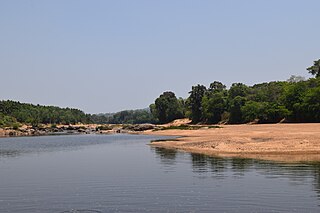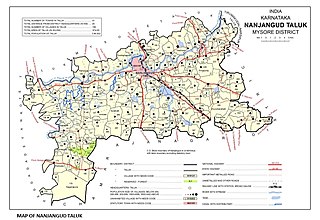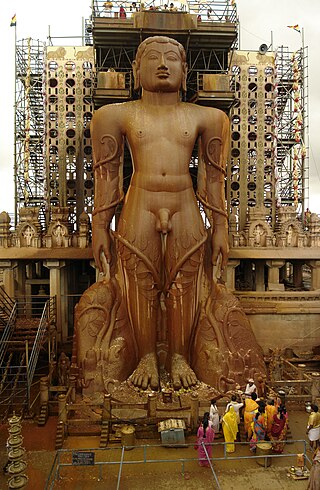
Koodli, also spelled Kudli or Kudali, is a small historic village in Shimoga District, in the Indian state of Karnataka. It is at the sangam (confluence) of two rivers, the Tunga River and Bhadra River at nearly 1,200 metres (3,937 ft). They meet here to give rise to the Tungabhadra River, a tributary of the Krishna river. Their valleys host many architectural sites. The village was a much larger town and pilgrimage center before the 14th-century, one destroyed during the Islamic conquests of the south. Important temples and their ruins here include the Jagadguru Sri Shankaracharya Dakshinamnaya Sringeri Sharada Peetham, Sangamesvara temple, Ramesvara temple, Sri Chintamani Narasimha temple, Sringeri Vediki temple, Vishwakarma temple, Sharadamba temple, Amma Devasthana, Brahmeswara temple and the Shree Madhvacharya Kudli Arya Akshobhya Tirtha Matha. Other scattered ruins of unknown temples are also found here.

Sringeri also called Shringeri is a hill town and Taluk headquarters located in Chikkamagaluru district in the Indian state of Karnataka. It is the site of the first maṭha established by Ādi Shankarāchārya, Hindu theologian and exponent of the Advaita Vedanta philosophy. Located on the banks of the river Tungā, the town draws a large number of pilgrims to its temples of Sri Sharadamba, Sri Vidyashankara, Sri Malahanikareshvara and other deities.

The Tunga River is a river in Karnataka state, southern India. The river is born in the Western Ghats(Sahyadri mountains) on a hill known as Varaha Parvata at a place called Gangamoola. From here, the river flows through two districts in Karnataka - Chikmagalur District and Shimoga District. It is 147 km long and merges with the Bhadra River at Koodli, a small town near Shimoga City, Karnataka. The river is given the compound name Tungabhadra from this point on. The Tungabhadra flows eastwards and merges with the Krishna River in Andhra Pradesh.

The Tungabhadra River starts and flows through the state of Karnataka, India, during most of its course, then through Andhra Pradesh, and ultimately joins the Krishna River near Murvakonda in Andhra Pradesh.
Sindhanur is a city and taluk headquarter of Sindhanur taluk of Raichur District in Karnataka. The river Tungabhadra covers the irrigation area by left bank canal. Most of the land in the field is composed of cultivable black soil. Paddy is cultivated using the Tungabhadra River water. Sindhanur is also known as the Paddy Granary of Raichur. With the availability of Tungabhadra river water, paddy rice is grown twice a year. Sindhanur is the place where the majority of tractor sales take place in Asia. as agricultural activities take place year-round. Sona Masuri and Basmati rice are grown in Sindhanur.Amba Matha also spelled as Amba Mutt is a village near Somalapura in the Sindhanur taluk. Amba Matha is a holy place, Sri Amba Devi Temple is located in the village. Sindhanur has a city municipal councill.

Nanjangud, officially known as Nanjanagudu, is a town in the Mysuru district of the Indian state of Karnataka. Nanjangud lies on the banks of the river Kapila, 23 km from the city of Mysore. Nanjangud is famous for the Srikanteshwara Temple located here. Nanjangud is also called Dakshina Kashi. This town is also famous for a type of banana grown in the region called the Nanjanagoodu rasabale. Nanjangud's local administrative unit was designated as a Municipal Committee in 2015 by including Devirammanahalli and Kallahalli village.

Dakṣiṇāmnāya Śrī Śāradā Pīṭham or Śri Śṛṅgagiri Maṭha ; Sanskrit: मठ, maṭha) is one amongst the four cardinal pīthams following the Daśanāmi Sampradaya - the peetham or matha is said to have been established by acharya Śrī Ādi Śaṅkara to preserve and propagate Sanātana Dharma and Advaita Vedānta, the doctrine of non-dualism. Located in Śringerī in Chikmagalur district in Karnataka, India, it is the Southern Āmnāya Pītham amongst the four Chaturāmnāya Pīthams, with the others being the Dvārakā Śāradā Pītham (Gujarat) in the West, Purī Govardhana Pīṭhaṃ (Odisha) in the East, Badri Jyotishpīṭhaṃ (Uttarakhand) in the North. The head of the matha is called Shankarayacharya, the title derives from Adi Shankara.
Harihara is a city in Davanagere District in the Indian state of Karnataka. It is the administrative headquarters of the Harihara Taluk. Harihara is famous for Harihareshwara temple.

Sirsi, also spelled as Shirasi is a city in the Uttara Kannada district of Karnataka state in India. It was also known as "Kalyana Pattana" during the Sonda Dynasty. It is a tourist destination with evergreen forest and waterfalls and is also a commercial centre. The main businesses around the city are mostly subsistence and agriculture-based. Areca nut or betel nut, locally known as Adike, is the primary crop grown in the nearby villages, making it one of the major trading centres for areca nut. The region is also known for spices such as cardamom, pepper, betel leaves, and vanilla. The major food crop is paddy.
Oyoor is a small township of Velinalloor village in the Kottarakara Taluk, Kollam District of Kerala, India. It is situated on the banks of the Ithikkara River. It is surrounded by several small satellite villages: Ugramkunnu in the south, Chenkulam in the west, Mylode in the north and Karingannoor in the east.
Kaladgi is a panchayat village in the Bagalkot Taluk, Bagalkot District of Karnataka State and is located about 25 km by road west of the town of Bagalkot. Kaladgi is well known for its fruit gardens.

Horanadu, also known as Sri Kshetra Horanadu, is a Hindu holy town and a Panchayat village located in kalasa taluk of Chikkamagaluru district, Karnataka, India. The town is famous for the Annapoorneshwari Temple. The main idol of the goddess is believed to have been consecrated by the sage Agastya; the new processional idol was consecrated in the temple in 1973. Horanadu has an elevation of 831 m (2,726 ft)
Hoovina Hadagali or Huvina Hadagali is a town and a taluk in the Vijayanagara district of Karnataka, India. It is the administrative headquarters of the HuvinaHadagali Taluk.

Karnataka, the sixth largest state in India, was ranked as the third most popular state in the country for tourism in 2014. It is home to 507 of the 3600 centrally protected monuments in India, second only to Uttar Pradesh. The State Directorate of Archaeology and Museums protects an additional 752 monuments and another 25,000 monuments are yet to receive protection.

Sri Sharadamba Temple is a famous Hindu temple dedicated to goddess Sharadamba in the holy town of Sringeri in Karnataka, India. It is located next to the Tunga river.

Athani is a town in the Belagavi district of Karnataka, India. It is 140 kilometers from the city of Belagavi, 70 kilometers from Vijayapura, 55 kilometers from Miraj, 100 kilometers from Kolhapur, and 624 kilometers from Bengaluru.
Vidyaranyapura Agrahara is a small village near Sringeri in the state of Karnataka, India. It houses several brahmin families associated with the Sringeri Sharada Peetham and local temples.
Bhandigadi is a small village in Koppa taluk, Chikkamagaluru district of Karnataka, India. Located on the banks of Tunga River, there is a Sri Veeradhadreshwara Temple located in heart of the village, the village also hosts matha- Shakatapura samsthanam. Kundadri hills, located far off from the place forms a scenic background to this village.
Savadi is a village in the southern state of Karnataka, India. It is located in the Athani taluk of Belgaum district. Located on the banks of the Krishna river, also called Uttaravahini - which flows northwards at Savadi, most of the population here is largely dependent on agriculture for its sustenance. Animals domesticated are buffaloes, goats, dogs, horse, bullocks, sheep and fowl. Historically being a belt of Jowar cultivation, with the recent irrigation projects near the village, from the past two decades, the chief crop has been sugarcane. Savadi is closely located to many sugar industries of the Krishna basin, and is part of the major supplier belt of sugarcane in Athani Taluk, and consequently Belgaum district.
Gandhinagar formerly known as Jalihal Camp, is one of the largest villages in Karnataka state in terms of area, population, property, agricultural production and revenue. It is the first government recognized revenue village in the Tunga Bhadra Delta Region. From 17 May 1997 onward, this village was renamed Gandhi Nagar from Jalihal Camp. is located on either sides of Tunga bhadra left Bank Canal,#36. In this village, there are many fertile, high-yielding paddy fields. Paddy is the main agricultural crop in the Tunga Bhadra Delta Region and the paddy varieties grown here include: Sonamasuri, Emergency, Ganga Kaveri, Nellore Sona, JJL, RS22.














